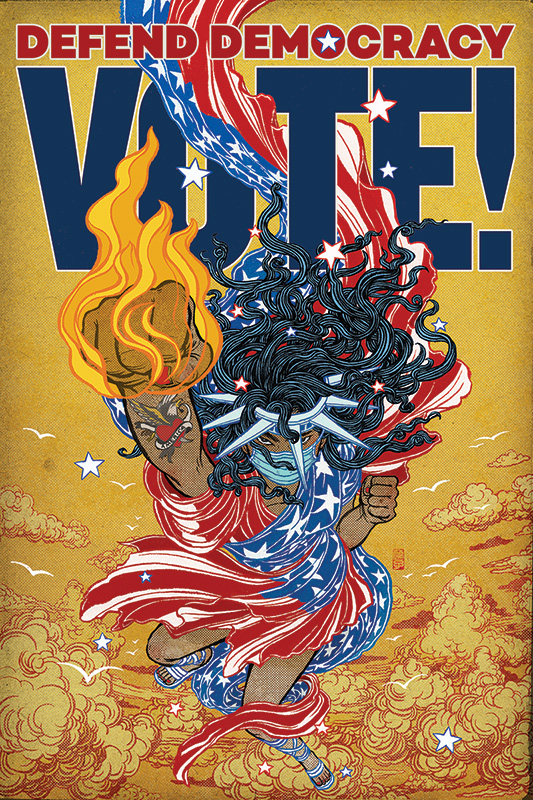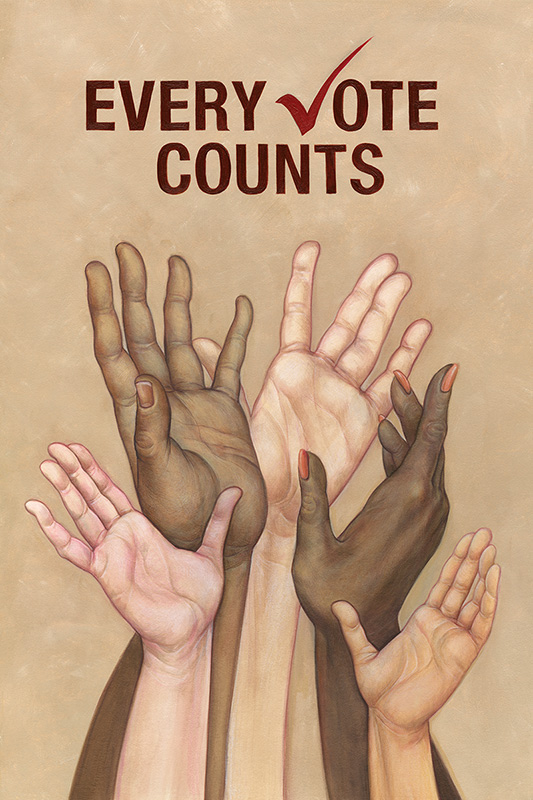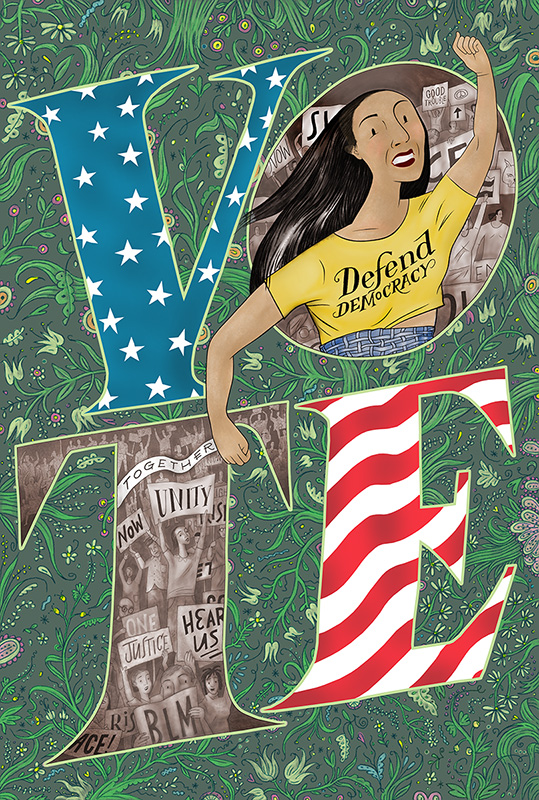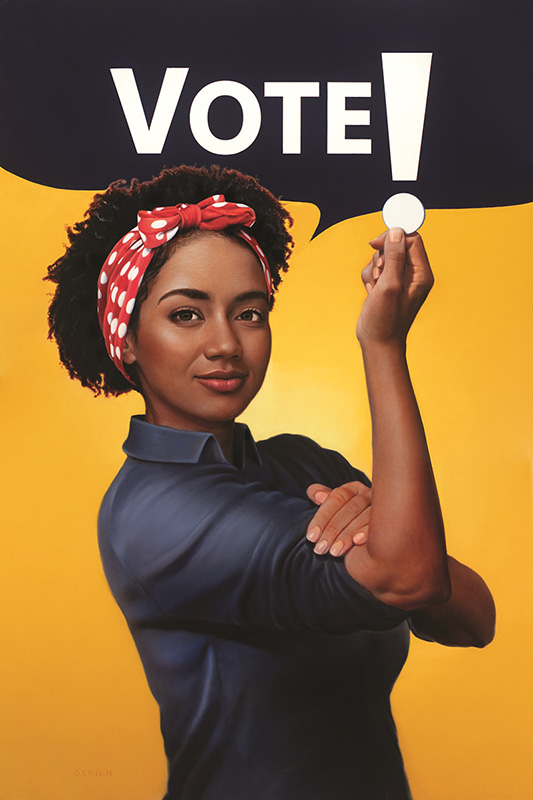Quick Pics: The Unity Project (week of 11/30/2020)
The Unity Project (2020)
Big Idea:
Every day we are surrounded by images which catch our attention and may even change our behavior. The Unity Project Images were created to encourage voting in the 2020 US Presidential Election where then President Donald Trump ran against Joseph Biden Jr.
Background :
Unity Project images were created to encourage voting and to show in real time the power of published imagery to make change. The images were created by some of the nation’s top illustrators. Millions of Americans viewed these images during the 2020 election season on Facebook and Instragam, and in news articles including this one from CNN.
To learn more about the artists and the project visit vote.nrm.org.
Mai Ly Degnan, Defend Democracy, 2020
Notice and Wonder:
- Who are the people in this image?
- What are they wearing?
- What are they doing?
- Why do you think Mai Ly Degnan put the words Defend Democracy on an image about voting?
Fun Facts:
Mai Ly Degnan loves drawing girls of all sizes, shapes and ethnicities. She also loves pattern and design. She put masks on the girls in this image to highlight the fact that the 2020 US Presidential Election occurred during a time when Covid-19 was spreading across the United States.
“In this piece, I wanted to illustrate a scene of strong women performing their civic duty of voting in this time of utmost uncertainty,” said Mai Ly Degnan, who notes that though we are in the midst of a pandemic, “this is not the time to be silent or sit this one out.”
Rudy Gutierrez, Sacred Scream/ Humanity, Not Politics, 2020
Notice and Wonder:
- Describe the action of the person in this image. What is she doing, how is she feeling, and how do you know?
- What words do you see and why are they important?
- Can you find the symbol for the coronavirus?
- What else do you notice?
Fun Facts:
Rudy Gutierrez feels “a deep sense of responsibility as a person of color, specifically of Puerto Rican heritage, to tell stories particularly from our point of view.” In his work, the artist addresses injustice. “Whether we scream sacredly from our hearts, minds, or souls, it is about voting for humanity, not politics, and each of us must do what we can where we stand.”
Yuko Shimizu, Defend Democracy (Lady Liberty) 2020
Design by Atelier Olschinsky Grafik und Design OG
Notice and Wonder:
- How is Yuko Shimizu’s Lady Liberty like the Statue of Liberty and how is she different?
- What details do you notice? Do any details surprise you?
- What is Lady Liberty wearing? How does the artist make her look strong and powerful?
Fun Facts:
In her poster design, Yuko Shimizu reimagined the Statue of Liberty as a superheroine, draped in the American flag, her torch replaced by a flaming fist. "Each individual voter is a superhero,” she said. “This is the beauty of democracy and we have to keep this intact. I wanted to create a poster that is unapologetically American, powerful and hopeful. This is a portrait of a contemporary woman of color as Lady Liberty Superheroine.”
Anita Kunz, Every Vote Counts, 2020
Notice and Wonder:
- What do you notice about this image?
- What is important about the position of the hands? What might they be reaching for?
Fun Facts:
Born in Canada, illustrator Anita Kunz became a citizen of the United States fifteen years ago. As reflected in her piece, “there are so many amazing cultures within this country,” she observed, “and the most important thing, and the thing that makes everyone feel included, is to vote.”
Whitney Sherman, Vote: Defend Democracy, 2020
Notice and Wonder:
- Notice the background, and the images in each letter. What themes does the artist invite us to think about?
- If you were old enough to vote would seeing this image encourage you to vote? Why or why not?
Fun Facts:
“When thinking about voting today, I’m mindful of the need to be vigilant...and of the energetic beauty that comes from everyone doing their part to be good citizens,” said Whitney Sherman, who found inspiration in movements including the Women’s March on Washington, Black Lives Matter protests, and the fight to address climate change.
“To vote means to participate in the experiment of democracy, an experiment that doesn’t continue on its own. It needs each and every one of us to exist.”
Tim O’Brien, Vote! 2020
Fun Facts:
In this piece, illustrator Tim O'Brien updated J. Howard Miller’s famous World War II icon, Rosie the Riveter, a symbol of women’s strength and determination for a new age. “African American women had a powerful role in the primary season and are likely to make a difference in the national elections this year,” said O’Brien, who reflected this observation in his art.
What you can do:
- Think about which one of these images would convince you to vote. What about the image speaks to you?
- Join a conversation to consider why voting is important. What would happen if nobody voted? Why is it positive for America when everyone with the right to vote exercises that right?
- Think about what you would include in an image to encourage voting. What story would you tell? Create an image and share it with us at vote.nrm.org
Image Resources
Mai Ly Degnan, Defend Democracy, 2020
Rudy Gutierrez, Sacred Scream/ Humanity, Not Politics, 2020
Rudy Gutierrez, Sacred Scream/ Humanity, Not Politics, 2020
Anita Kunz, Every Vote Counts, 2020
Whitney Sherman, Vote: Defend Democracy, 2020
Tim O’Brien, Vote! 2020
Image Credits:
Mai Ly Degnan
Defend Democracy, 2020
Digital
Mai Ly Degnan © 2020. All rights reserved.
Rudy Gutierrez
Humanity, Not Politics, 2020
Acrylic, colored pencil, crayon on Bristol paper mounted on board
Rudy Gutierrez © 2020. All rights reserved.
Anita Kunz
Every Vote Counts, 2020
Acrylic on board Anita Kunz
© 2020. All rights reserved.
Tim O’Brien
Vote, 2020
Oil on board
Tim O’Brien © 2020. All rights reserved.
Whitney Sherman
Vote: Defend Democracy, 2020
Digital
Whitney Sherman © 2020. All rights reserved.
Yuko Shimizu
Defend Democracy (Lady Liberty), 2020
Digital
Design by Atelier Olschinsky Grafik und Design OG
Yuko Shimizu © 2020. All rights reserved.
- Grade
- K-6
- Theme
- Quick Pics
- Length
- Each Quick Pic activity is about 5-10 minutes in duration, with each being taught one image per day over a week.
- Discipline
- Social Studies, Language Arts: Speaking and Listening, Art
- Vocabulary
- democracy, vote, election, published imagery, contemporary artist
Standards
This curriculum meets the standards listed below. Look for more details on these standards please visit: ELA and Math Standards, Social Studies Standards, Visual Arts Standards.
- CCSS.ELA-Literacy.CCRA.L.1
- Demonstrate command of the conventions of standard English grammar and usage when writing or speaking.
- CCSS.ELA-Literacy.CCRA.L.2
- Demonstrate command of the conventions of standard English capitalization, punctuation, and spelling when writing.
- CCSS.ELA-Literacy.CCRA.L.3
- Apply knowledge of language to understand how language functions in different contexts, to make effective choices for meaning or style, and to comprehend more fully when reading or listening.
- CCSS.ELA-Literacy.CCRA.L.4
- Determine or clarify the meaning of unknown and multiple-meaning words and phrases by using context clues, analyzing meaningful word parts, and consulting general and specialized reference materials, as appropriate.
- CCSS.ELA-Literacy.CCRA.L.5
- Demonstrate understanding of figurative language, word relationships, and nuances in word meanings.
- CCSS.ELA-Literacy.CCRA.L.6
- Acquire and use accurately a range of general academic and domain-specific words and phrases sufficient for reading, writing, speaking, and listening at the college and career readiness level; demonstrate independence in gathering vocabulary knowledge when encountering an unknown term important to comprehension or expression.
- CCSS.ELA-Literacy.CCRA.SL.1
- Prepare for and participate effectively in a range of conversations and collaborations with diverse partners, building on others' ideas and expressing their own clearly and persuasively.
- CCSS.ELA-Literacy.CCRA.SL.2
- Integrate and evaluate information presented in diverse media and formats, including visually, quantitatively, and orally.
- CCSS.ELA-Literacy.CCRA.SL.3
- Evaluate a speaker's point of view, reasoning, and use of evidence and rhetoric.
- CCSS.ELA-Literacy.CCRA.SL.4
- Present information, findings, and supporting evidence such that listeners can follow the line of reasoning and the organization, development, and style are appropriate to task, purpose, and audience.
- CCSS.ELA-Literacy.CCRA.SL.5
- Make strategic use of digital media and visual displays of data to express information and enhance understanding of presentations.
- CCSS.ELA-Literacy.CCRA.SL.6
- Adapt speech to a variety of contexts and communicative tasks, demonstrating command of formal English when indicated or appropriate.





